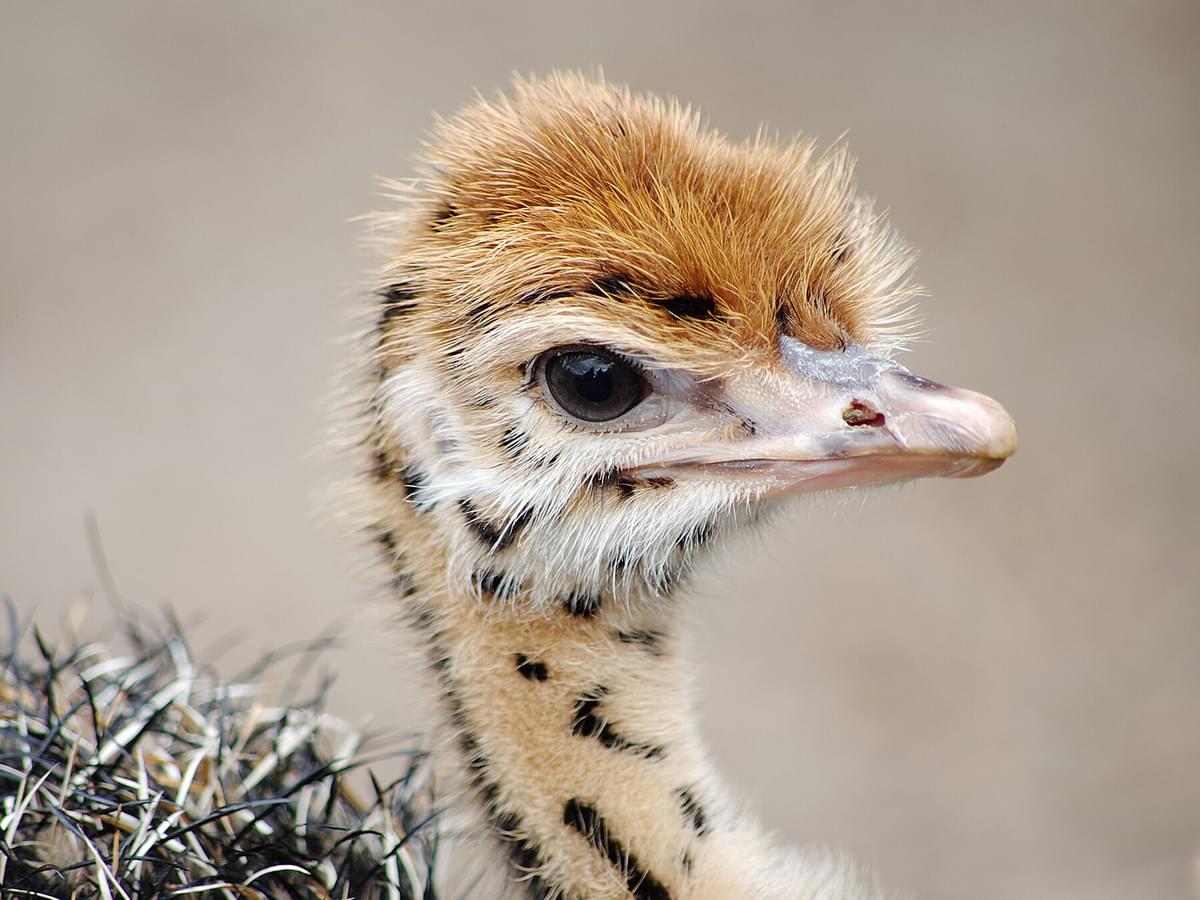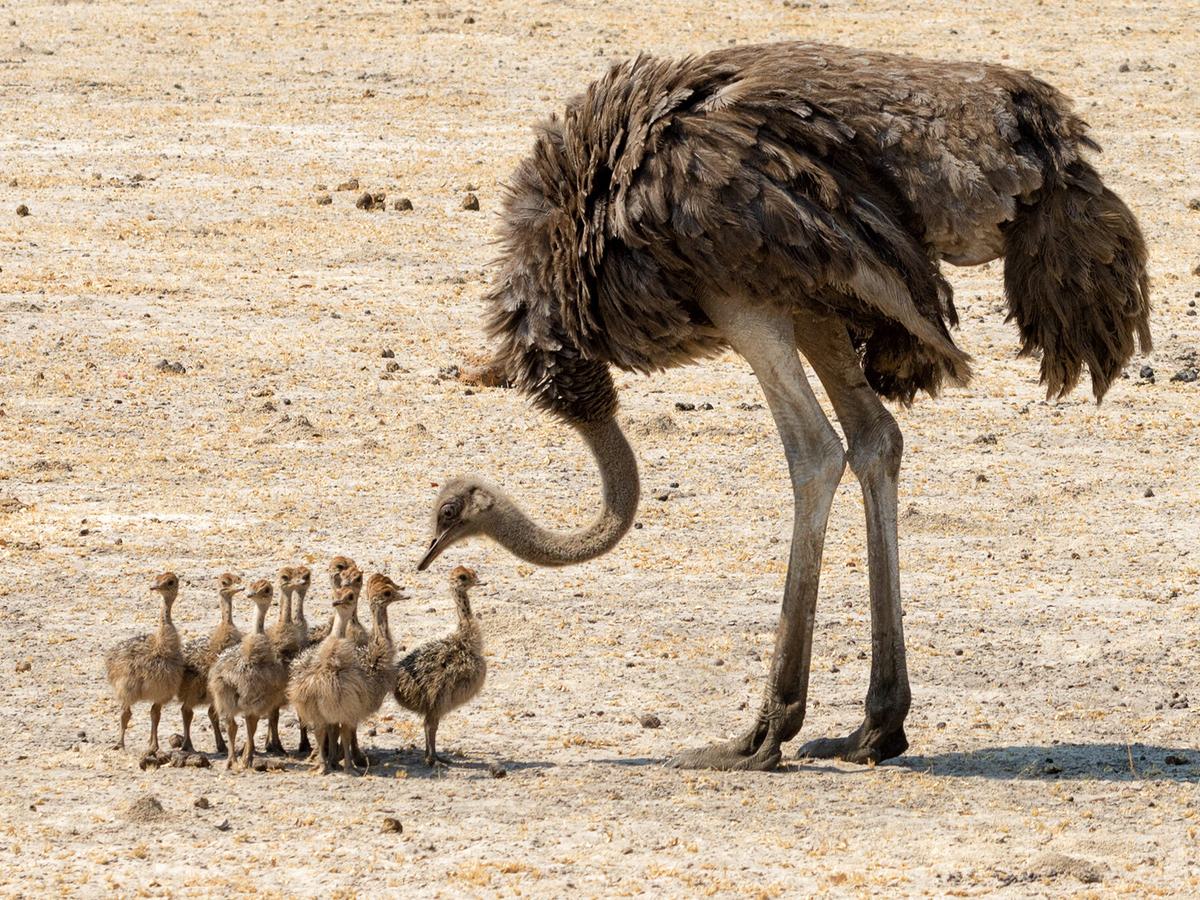Jump to Section
Baby Ostriches: All You Need to Know (with Pictures)
Last updated: 9 October 2022

The mighty ostrich is comfortably the biggest and heaviest bird in the world, standing at some 2.1 to 2.8 m (6 ft 11 to 9 ft 2 in) tall and weighing some 150kg (23.5 stone). It may come as no surprise then that ostrich eggs are also the biggest eggs of any animal in the world, the world record-holding egg weighs 2.589 kg (5 lb 11.36 oz)!
We mostly hear about ostriches because of their size, weight and running abilities, but what about ostrich chicks? This article will explore baby ostriches, their size, behaviour and everything else you need to know. There will be plenty of photos of baby ostriches along the way!
What does a baby ostrich look like?
At birth, ostrich hatchlings resemble adults in terms of their shape at least, with long necks and plump, ovular bodies. Their plumage is much lighter in colour, with beige spikey, thin feathers covering much of their body. Baby ostriches have distinctive striped necks with speckles of darker brown.

Ostrich chick
How big are baby ostriches?
It probably won’t come as a surprise to learn that ostrich chicks are the biggest of all chicks, measuring around 25cm (10 in) tall and weighing around 1 to 1.2kg (2 to 2.6lb).
This makes ostrich chicks more or less the same size as a small chicken, and much bigger than many fully grown birds! Once the chicks hatch, they’re relatively dormant for around a day or so but can walk by day 2 or 3, at which point they’ll start running around after each other and their parents.
How much do baby ostriches weigh?
Ostrich chicks usually weigh between 1 to 1.2kg (2 to 2.6lb), which makes them the heaviest chick of any bird by a comfortable margin.
For comparison, a baby chicken is just around 30g - baby ostriches are 50 times heavier! They grow very quickly, too, reaching adult size in around a year. That means they grow around 30cm every single month, hitting the 70kg mark at around six months. A fully grown adult ostrich may weigh as much as 156.8 kg (346 lb).

A mother with her brood of ostrich babies, on the plains of Kenya
What do juvenile ostriches look like?
That depends on whether the juvenile is male or female, as female ostriches retain their lighter, more drab feathers, whereas male ostriches grow dark black plumage by the time they reach sexual maturity.
Male juvenile ostriches slowly lose their more shaggy, lighter brown feathers and grow darker black or near-black feathers across their large wings. They’ll remain speckled and lighter coloured for most of a year. Juvenile ostrich necks are a lighter, more neutral colour and turn pink into adulthood, as do their legs.
The plumage of female juvenile ostriches will look quite similar to that of juvenile ostriches, remaining a sand-like beige.

A male adult ostrich, surrounded by many juvenile ostriches
What is a baby ostrich called?
A baby ostrich is simply called a chick. After hatching from the egg, baby ostriches are called hatchlings, they’re called a nestling whilst they remain in the nest and then a fledgling once they leave the nest.
Since ostrich chicks cannot fly, they fledge when they leave their nest and start following their parents on foot, which happens within just days of hatching.
What is a group of baby ostriches called?
A group of baby ostriches is typically called a brood. A group of juvenile or adult ostriches is usually called a herd.

A group of baby ostriches running down a dry road together
What do baby ostriches eat?
Baby ostriches absorb vast amounts of yolk from their egg’s yolk sac, which usually keeps them sustained on nutrients for up to a week.
During this period, they will learn to walk and begin to follow their parents or other adult ostriches who will guide them to food to forage. There is no parental feeding - baby ostriches feed themselves instinctively.
As omnivorous birds, ostriches consume a wide range of plant food and meat in the form of arthropods and insects as well as small rodents, lizards, snakes and most other nutritious foods present in their harsh environments. Baby ostriches will follow their parent’s cues, who will peck at viable food and encourage their chicks to eat through vocalisations.

Ostrich chick foraging for food
Do both parents feed baby ostriches?
No, but the parents do guide them to food and encourage them to eat.
The parents also encourage chicks to eat via calls and vocalisations. It may not always be the biological parents that do the parenting either, as ostrich chicks form communal creches of some 40 birds or more that are looked after by one or two adult ostriches who take on parenting roles for the whole creche.

Close up of a young Ostrich
How do ostriches feed their chicks?
Ostrich parents don’t actively feed their chicks - the chicks feed instinctively after around a week or so. Ostrich chicks walk within just days of hatching and follow their parents, observing and copying their feeding behaviours.
Baby and juvenile ostriches grow exceptionally quickly at a rate of some 30cm a month and are able to feed upon adult-size food after around 1 to 2 months.
What do ostrich eggs look like?
Firstly, ostrich eggs are huge and can weigh as much as 2kg, easily the biggest eggs in the entire animal kingdom. They are around 15cm (6in) in length and 12.5cm (5in) in diameter and are glossy white to cream-coloured, with exceptionally thick shells and small pits.
Ostriches use communal nests that contain some 20 eggs or so and incubation is shared by both males and females, typically the female during the day - who blends into the sand with her drab beige plumage - and the male at night who blends into the darkness with his black plumage.
In communal nests, it’s usually the ‘major hen’ that incubates the eggs, which is the dominant hen of the flock, but this can differ throughout the incubation period. Ostrich breeding hierarchies are complex and there’s much left to learn, particularly in the case of the rarer Somalian ostrich.

Ostrich with their eggs
How long do ostrich eggs take to hatch?
Ostrich eggs are incubated for a long period of 42 to 46 days, which is an above-average incubation period for a bird in a warm climate. This is likely because the eggs are just so massive, but also, nighttime ground temperatures can plummet, and ostrich nests are quite uninsulated.
How many babies does an ostrich have?
Ostrich egg laying is complex, mainly because there is a hierarchy that prioritises the dominant, 'major hen', who tends to lay the first eggs. The major hen also lays the most eggs (up to 10), which are also usually positioned in the centre of the nest.
Other hens typically lay between 4 to 6 eggs, up to a maximum of around 20 per nesting hole. Each nest will be shared by 2 to 5 hens. How this hierarchy is established and why is somewhat of a mystery.
Once hatched, the ostrich chicks are looked after by the parents of each respective brood, but ostrich chicks also form creches of up to 40 birds that are looked after communally. Sometimes they might be with their parents, and other times, they'll be in their own flock in the creche.
Parental clashes can occur, which result in the transfer of one parent's brood to another set of parents. Rarely, ostrich parents have been recorded with some 300 chicks as a result of these encounters. The breeding behaviours of Somali ostriches are thought to be similar to the Common ostrich, though there is less robust evidence available.

Female ostrich with many chicks
When do ostriches lay eggs?
The ostrich breeding season often synchronises with the coming of rains in around June to October in East Africa and March to April, or August to October in South-East Africa and Kenya. Breeding in the dry season has also been recorded in some regions.
How long do baby ostriches stay with their parents?
Ostrich chicks remain close to their parents for around two months, at which point they gain some independence but remain with the same flock - or herd - until they’re around one year old. Ostrich chicks have been observed retaining parental contact for up to 1 year.
Ostrich chicks will follow their parents for a portion of the day, but they also form communal creches of some 20 to 40 baby birds which are closely guarded by a single male or a male and a female. The adult supervisors protect the birds from predators and are often observed sheltering the chicks from the sun with their enormous wings.

A family of Ostriches together in Kenya
Creche behaviour is relatively rare across birds, but the young of some penguins, flamingos, terns and eiders also form creches.
Creches often form when most of the other adult ostriches are foraging for food or locating water, etc. Creches can merge together into enormous broods of hundreds of birds, and it’s often unclear whether chicks become mismatched with different parents, or whether this even matters so long as the chicks remain under the supervision of an adult.
On this page
- What does a baby ostrich look like?
- How big are baby ostriches?
- How much do baby ostriches weigh?
- What do juvenile ostriches look like?
- What is a baby ostrich called?
- What is a group of baby ostriches called?
- What do baby ostriches eat?
- Do both parents feed baby ostriches?
- How do ostriches feed their chicks?
- What do ostrich eggs look like?
- How long do ostrich eggs take to hatch?
- How many babies does an ostrich have?
- When do ostriches lay eggs?
- How long do baby ostriches stay with their parents?








